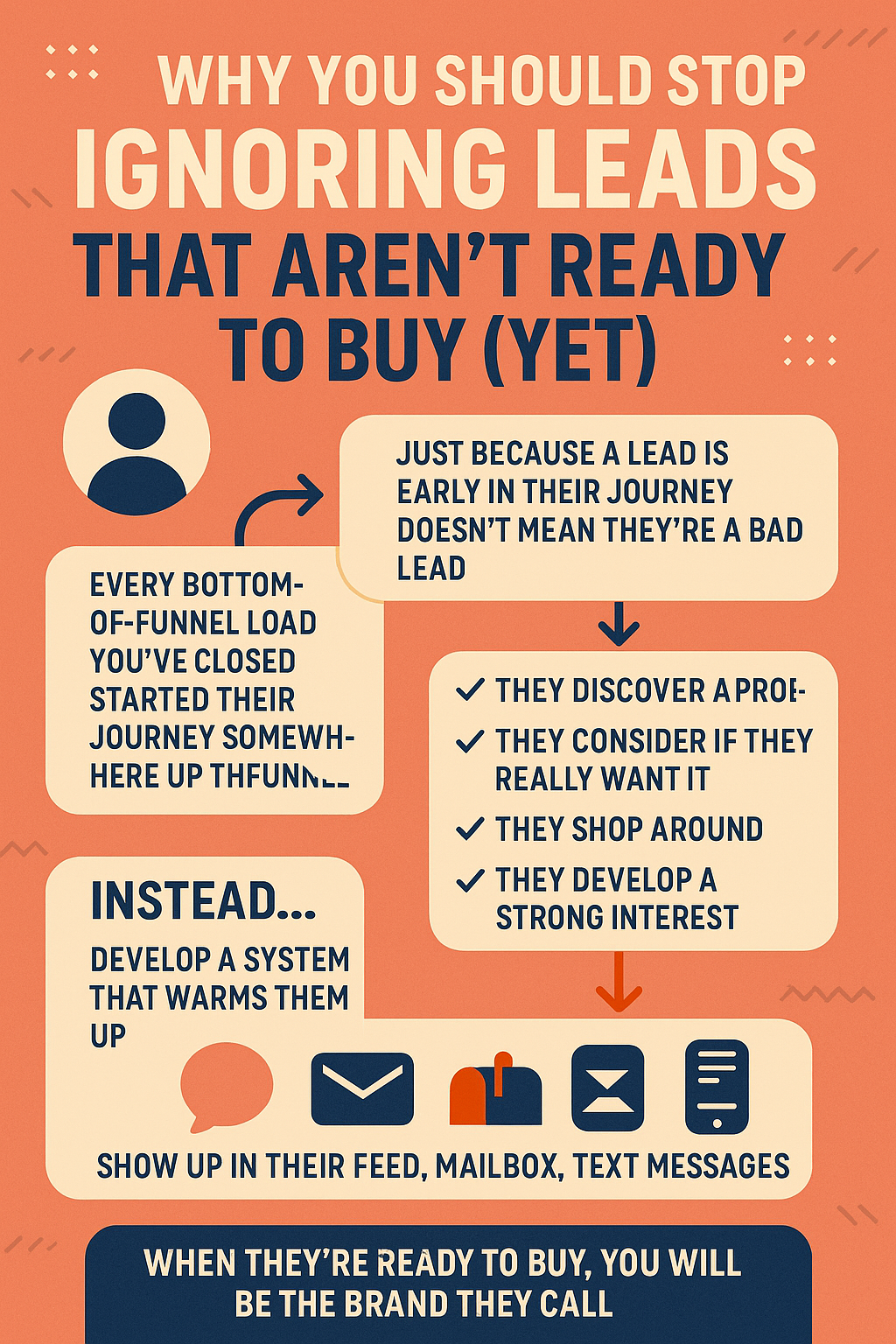If your product or service carries a hefty price tag—say $10,000 or more—you already know the truth: big deals rarely close in a single call.
And yet, many B2B marketers and sales teams fall into the same trap.
They chase only “ready-to-buy” leads—those sitting at the very bottom of the funnel—ignoring everyone else. The logic seems sound: focus your energy on the hottest leads and you’ll close more deals faster. But in reality, it’s a short-sighted strategy that limits your pipeline and leaves massive revenue on the table.

The Misconception: “High Funnel = Bad Lead”
There’s a common belief that if someone isn’t ready to talk pricing today, they’re not worth your time.
But that couldn’t be further from the truth.
Just because a lead is early in their journey doesn’t mean they’re a bad lead. It just means they’re not ready yet. And guess what? Every bottom-of-funnel lead you’ve ever closed started their journey somewhere higher up in the funnel.
Here’s how it typically goes:
- They discover a product or hear about a solution.
- They begin researching—checking out blog posts, videos, webinars, product reviews.
- They weigh their options.
- They engage with content: download a guide, sign up for a newsletter, watch a demo.
- They follow your brand on social or start seeing you show up in retargeting ads.
- A few weeks—or months—later, they’re in buying mode.
That journey happens whether you pay attention to it or not. The question is: are you there for them along the way?
Why Bottom-of-Funnel Is Not Enough
Sure, bottom-of-funnel leads are great. They convert faster. They often come through high-intent channels like branded Google searches or direct referrals. But here’s the issue:
- They’re a small pool.
- They’re expensive to acquire.
- They’re highly competitive.
- And most importantly: they aren’t scalable.
The majority of your total addressable market isn’t searching “buy [your product] today.” They’re in research mode, problem-aware but not solution-ready.
And if you ignore those folks? Someone else will warm them up—probably your competitor.
The Case for a Warming System
Rather than disqualify early-stage leads, your job is to develop them. You need a lead warming system—something that helps guide potential buyers down the funnel until they’re ready to raise their hand.
Think of it like this: you’re not selling to someone who’s uninterested. You’re selling to someone who’s not yet convinced.
Your job isn’t to push—it’s to nurture.
Here’s how:
1. Content That Meets Them Where They Are
Top and middle-of-funnel leads don’t want a sales call—they want insights. Create content that speaks to their challenges and questions at each stage:
- Blog posts that explain problems (not just your solution)
- Comparison guides and buying checklists
- Educational videos and short demos
- Case studies that show results without hard selling
2. Follow-Up Without the Hard Sell
Not every lead form should trigger a “book a call” email. Consider a drip email sequence that builds trust:
- Start with value: helpful articles, short tips, or industry trends.
- Then introduce social proof: case studies, testimonials, customer wins.
- Finally, invite engagement: “Have questions?”, “Want a free audit?”, or “Would a guide help you choose?”
Remember: the best email isn’t always the one that converts—it’s the one that keeps the door open.
3. Be Everywhere (Without Being Annoying)
Warming leads isn’t just about email. Think multi-channel:
- Retarget visitors with valuable content (not just demo requests)
- Show up in their social feed with thought leadership
- Send direct mail (yes, physical!) for big-ticket B2B items
- Text when appropriate—especially if they’ve opted in
When they see your brand consistently across channels, it builds familiarity and trust.
4. Use Signals to Score Readiness
Not every warm lead is warm in the same way.
By using behavioral signals, you can start to identify when a top-of-funnel lead becomes a sales-ready one. For example:
- Revisited your pricing page multiple times? Bump their lead score.
- Downloaded a comparison guide after months of inactivity? Time to re-engage.
- Opened every email in your nurture series? They’re interested—call them.
This lets you prioritize outreach and avoid pushing too early.
Build for the Journey, Not the Quick Win
Every high-ticket deal is a journey. And the sooner you stop looking for shortcuts, the sooner your pipeline becomes more predictable, profitable, and durable.
You don’t need 1,000 red-hot leads. You need 100 that are nurtured properly. When you show up with value, patience, and consistency—before the sale—you earn trust.
That trust is what wins the deal when your competitor sends their first cold email.
A Quick Story
Let’s say you’re selling enterprise IT solutions. A prospect named Sarah finds your blog post while searching for “ways to improve IT security in manufacturing.”
She’s not ready to buy. But she:
- Downloads your security checklist
- Starts getting your emails
- Clicks on one case study two weeks later
- Joins a webinar your team hosts
- Sends your content to a peer
- Finally, six weeks in, she books a demo
Was she a bad lead when she first downloaded that checklist? Not at all.
But if you only focused on bottom-of-funnel leads, you would’ve missed her entirely.
Final Thoughts
Warming leads isn’t optional when you’re selling big-ticket products—it’s essential.
Yes, bottom-of-funnel traffic is great. But it’s limited. If you want to grow predictably, you need to invest in the full funnel—and that means showing up early, often, and meaningfully.
Don’t just wait for ready-to-buy leads.
Create them.

Hi there! I’m Scott, and I am the principal consultant and thought leader behind Stratus Analytics. I have a Master of Science degree in marketing analytics, and I’ve have been providing freelance digital marketing services for over 20 years. Additionally, I have written several books on marketing which you can find here on Amazon or this website.
DISCLAIMER: Due to my work in the packaging industry, I cannot take on freelance clients within the packaging manufacturing space. I do not want to provide disservice to your vision or my employer. Thank you for understanding.
